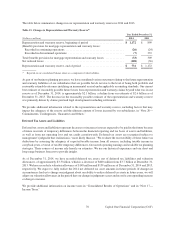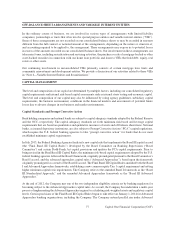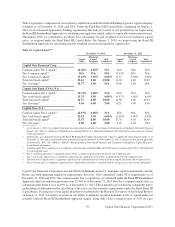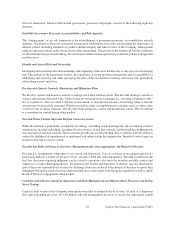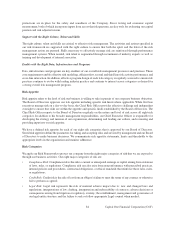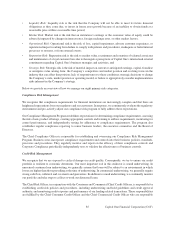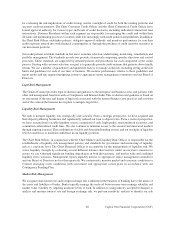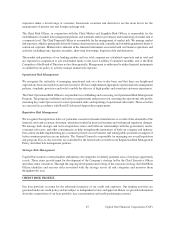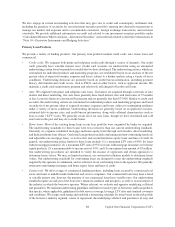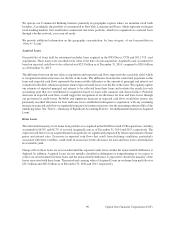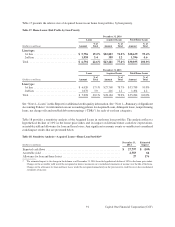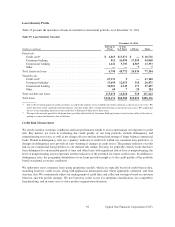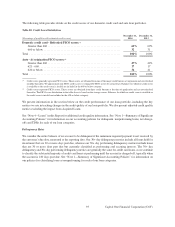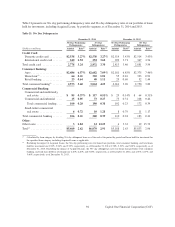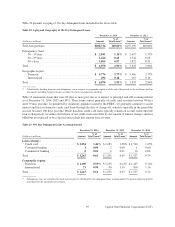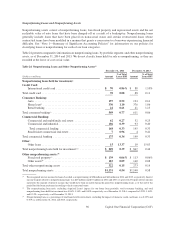Capital One 2014 Annual Report Download - page 108
Download and view the complete annual report
Please find page 108 of the 2014 Capital One annual report below. You can navigate through the pages in the report by either clicking on the pages listed below, or by using the keyword search tool below to find specific information within the annual report.for evaluating the risk implications of credit strategy and for oversight of credit for both the existing portfolio and
any new credit investments. The Chief Consumer Credit Officer and the Chief Commercial Credit Officer have
formal approval authority for various types and levels of credit decisions, including individual commercial loan
transactions. Division Presidents within each segment are responsible for managing the credit risk within their
divisions and maintaining processes to control credit risk and comply with credit policies and guidelines. In addition,
the Chief Risk Officer establishes policies, delegates approval authority and monitors performance for non-loan
credit exposure entered into with financial counterparties or through the purchase of credit sensitive securities in
our investment portfolio.
Our credit policies establish standards in five areas: customer selection, underwriting, monitoring, remediation, and
portfolio management. The standards in each area provide a framework comprising specific objectives and control
processes. These standards are supported by detailed policies and procedures for each component of the credit
process. Starting with customer selection, our goal is to generally provide credit on terms that generate above hurdle
returns. We use a number of quantitative and qualitative factors to manage credit risk, including setting credit risk
limits and guidelines for each of our lines of business. We monitor performance relative to these guidelines and
report results and any required mitigating actions to appropriate senior management committees and our Board of
Directors.
Legal Risk Management
The General Counsel provides legal evaluation and guidance to the enterprise and business areas and partners with
other risk management functions such as Compliance and Internal Audit. This evaluation and guidance is based on
an assessment of the type and degree of legal risk associated with the internal business area practices and activities
and of the controls the business has in place to mitigate legal risks.
Liquidity Risk Management
We seek to mitigate liquidity risk strategically and tactically. From a strategic perspective, we have acquired and
built deposit gathering businesses and significantly reduced our loan to deposit ratio. From a tactical perspective,
we have accumulated a sizable liquidity reserve comprised of cash, high-quality, unencumbered securities, and
committed collateralized credit lines. We also continue to maintain access to the secured and unsecured markets
through ongoing issuance. This combination of stable and diversified funding sources and our stockpile of liquidity
reserves enables us to maintain confidence in our liquidity position.
The Chief Risk Officer, in conjunction with the Chief Market and Liquidity Risk Officer, is responsible for the
establishment of liquidity risk management policies and standards for governance and monitoring of liquidity
risk at a corporate level. The Chief Financial Officer is accountable for the management of liquidity risk. We
assess liquidity strength by evaluating several different balance sheet metrics under severe stress scenarios to
ensure we can withstand significant funding degradation in both idiosyncratic, and market wide and combined
liquidity stress scenarios. Management reports liquidity metrics to appropriate senior management committees
and our Board of Directors no less than quarterly. We continuously monitor market and economic conditions to
evaluate emerging stress conditions with assessment and appropriate action plans in accordance with our
Contingency Funding Plan.
Market Risk Management
We recognize that interest rate and foreign exchange risk is inherent in the business of banking due to the nature of
the assets and liabilities of banks. Banks typically manage the trade-off between near-term earnings volatility and
market value volatility by targeting moderate levels of each. In addition to using industry accepted techniques to
analyze and measure interest rate and foreign exchange risk, we perform sensitivity analysis to identify our risk
86 Capital One Financial Corporation (COF)


